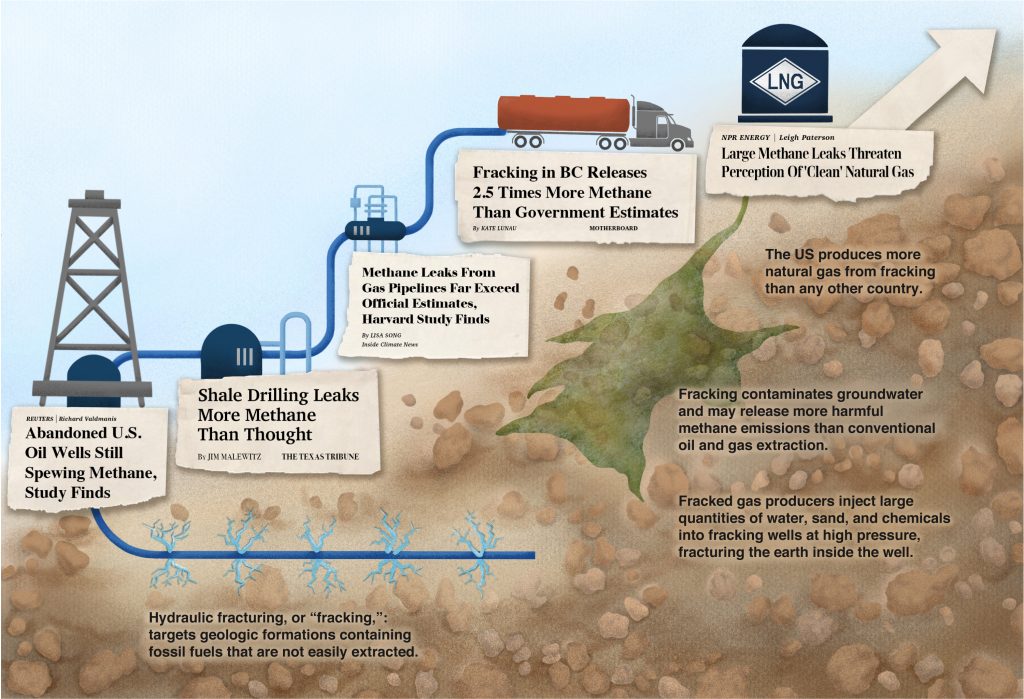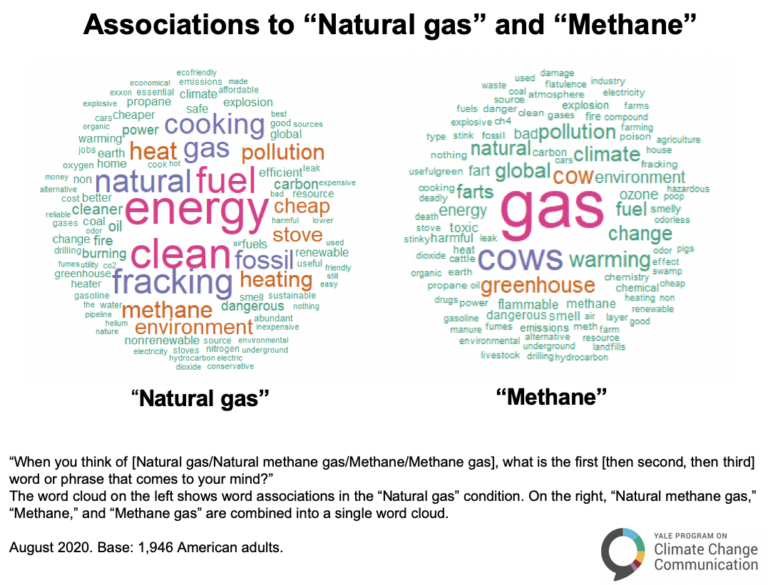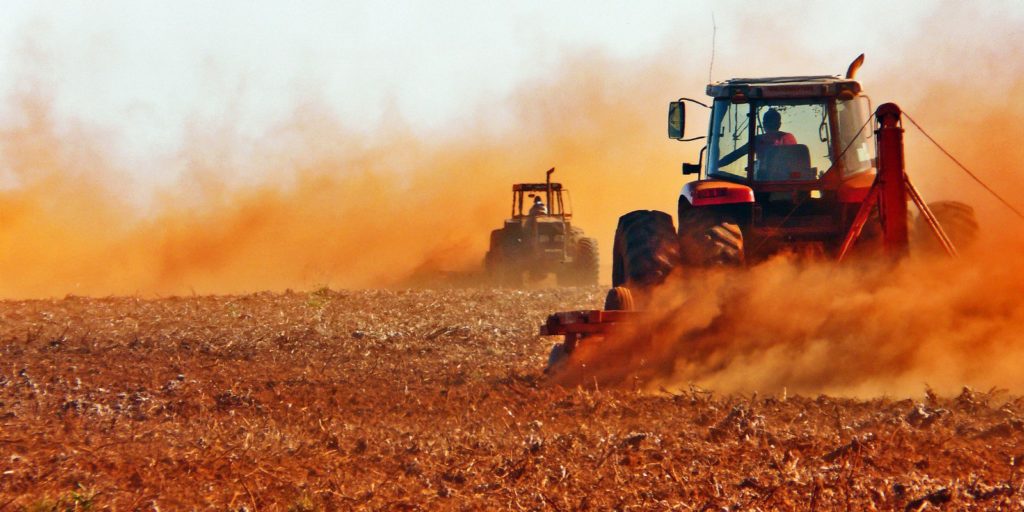Addressing methane emissions is the most pressing emissions issue
Addressing methane is the most pressing issue we should address so as to prevent more heat-trapping, climate-warming emissions in our atmosphere. Methane is Like CO2 on Steroids says a Sightline Institute article. It’s not the only scientific article warning of the critical and immediate threat to our atmosphere and the livability of planet.
What’s the problem with methane?
Methane traps atmospheric heat 87 times more effectively than CO2. Worse yet, it then becomes CO2 itself. In its gaseous form, methane is one of the most potent greenhouse gases, warming the Earth about 30 times more efficiently than carbon dioxide. Also, methane emissions contain harmful cancer-causing air toxins and contribute to the formation of smog-forming pollutants, like ground-level ozone which are bad for human health.
Natural gas and methane’s climate impact
Natural gas’s climate impact is 34 times worse than CO2 over a 100-year time frame. And it accumulates. Natural gas is composed of 70-90% methane. And there is a lot of it locked up in melting ice caps and permafrost. And, industrial farming and the raising of cattle is a significant contributor to new emissions of methane. You can see how the cumulative effects start to ramp up the risk.
Methane is responsible for about 25% of climate change
Methane concentrations have increased by 150% or more due to industrial pollution. And, intensive agriculture is a big part of the increase. After CO2, it’s estimated that methane is responsible for almost 25% of the climate change occurring in the 20th Century. Understanding possible sources of atmospheric methane is critical for accurately predicting future climate change.
Where does methane come from?
NASA says that methane comes from many sources and is produced under conditions where little to no oxygen is available.
- About 30% of methane emissions are produced by wetlands, including ponds, lakes and rivers.
- Another 20% is produced by agriculture, due to a combination of livestock, waste management and rice cultivation.
- Activities related to oil, gas, and coal extraction release an additional 30%.
- The remainder of methane emissions come from minor sources such as wildfire, biomass burning, permafrost, termites, dams, and the ocean.
- Manmade methane from burning natural gas and lighting off “excess” natural gas bi-products is a big problem.
But there is a more serious problem lurking beneath our ice caps. This Science Daily report says, “Beneath the cold, dark depths of the Arctic ocean sit vast reserves of methane. These stores rest in a delicate balance, stable as a solid called methane hydrates, at very specific pressures and temperatures. If that balance gets tipped, the methane can get released into the water above and eventually make its way to the atmosphere.”
Cows are gas giants
You might not know this, but cows are “gas giants” and burp or breathe a lot of methane. In fact, agriculture and livestock farming generate around 40 percent of the methane related to human activities, the rest produced by the fossil fuel industry. Much of that methane is produced by the digestive process in cows, which then burp the emissions out into the world. Research is being done to create a mask that filters out the methane emissions from a cow’s mouth and nostrils. Danish research has been done on adding oregano to cow’s feed creating special formulations of food so they produce less methane gas. Feeding cows oregano might help “rein in the bovine burps.”

Methane is lurking beneath our ice caps
The last ice age created miles-thick layers of ice. Their huge amounts of methane hydrates were locked in an icy mixture of gas and water, reports Science Alert. But between 17,000 and 15,000 years ago, when the climate began to warm up, rapid deglaciation on the surface allowed methane deposits to break through this icy protective layer. The gas can exert pressure of such force as to push up the sea floor creating “massive underwater domes called pingos that could stretch for up to a kilometer long.”
 Siberian sinkhole due to methane release and subsequent collapse
Siberian sinkhole due to methane release and subsequent collapse
https://www.cnn.com/2021/02/17/world/siberia-craters-arctic-climate-change-scn/index.html
Science Alert reports that the same sinkhole phenomena is happening in Siberia right now. Locals there see thousands of gas bubbles destabilizing the earth and threatening to collapse into gigantic sinkholes and craters without warning.
Natural gas is perceived positively because of its name
While the natural gas producers want you to think that their product is natural, the burning of it is unnaturally contributing to a lot of heat-trapping potential now and even worse, the harm is baked into the future. Would people be as inclined to use natural gas if it was called what it really is – methane?
The well-respected Yale Communications announced in December 2020 survey results on the US public’s perception of natural gas. The American public perceives “natural gas” much more favorably (76% favorable) than other fossil fuels like oil (51% ) or coal (39%). They also believe natural gas is much less harmful to human health than is coal or oil. They also say that the coined reference to natural has greenwashed people into thinking it’s harmless.

US announces it’s taking action on methane
The Sightline Institute says, methane’s 20-year climate effect must be taken seriously. Even when scientist’s calculations differ on the potential damage, it’s not because they are wrong on the threat to the global warming potential of methane. It’s because they are looking over different time frames ranging from 20 to 100 years in the future.
We must act quickly on multiple fronts and sectors in policy and action on the nearer-term impacts of methane burning, fracking, agricultural contributions, and use. Some people won’t like it. Industry will push back. It will complicate how we produce our food and the cattle industry.
Even the Dallas Morning News admits that Biden is right in regulating methane emissions.
 The Perils of Industrial Agriculture | by Jeff Pawlak | Medium
The Perils of Industrial Agriculture | by Jeff Pawlak | Medium
Some good news is on the horizon. On November 2, 2021, the US announced a sweeping set of regulations and initiatives to drastically reduce methane emissions in agriculture. Methane emissions from animal agriculture are a significant contributor to global warming. The regulatory push spans across the multiple agencies responsible for agriculture, energy, the environment, housing, land management, and transportation.